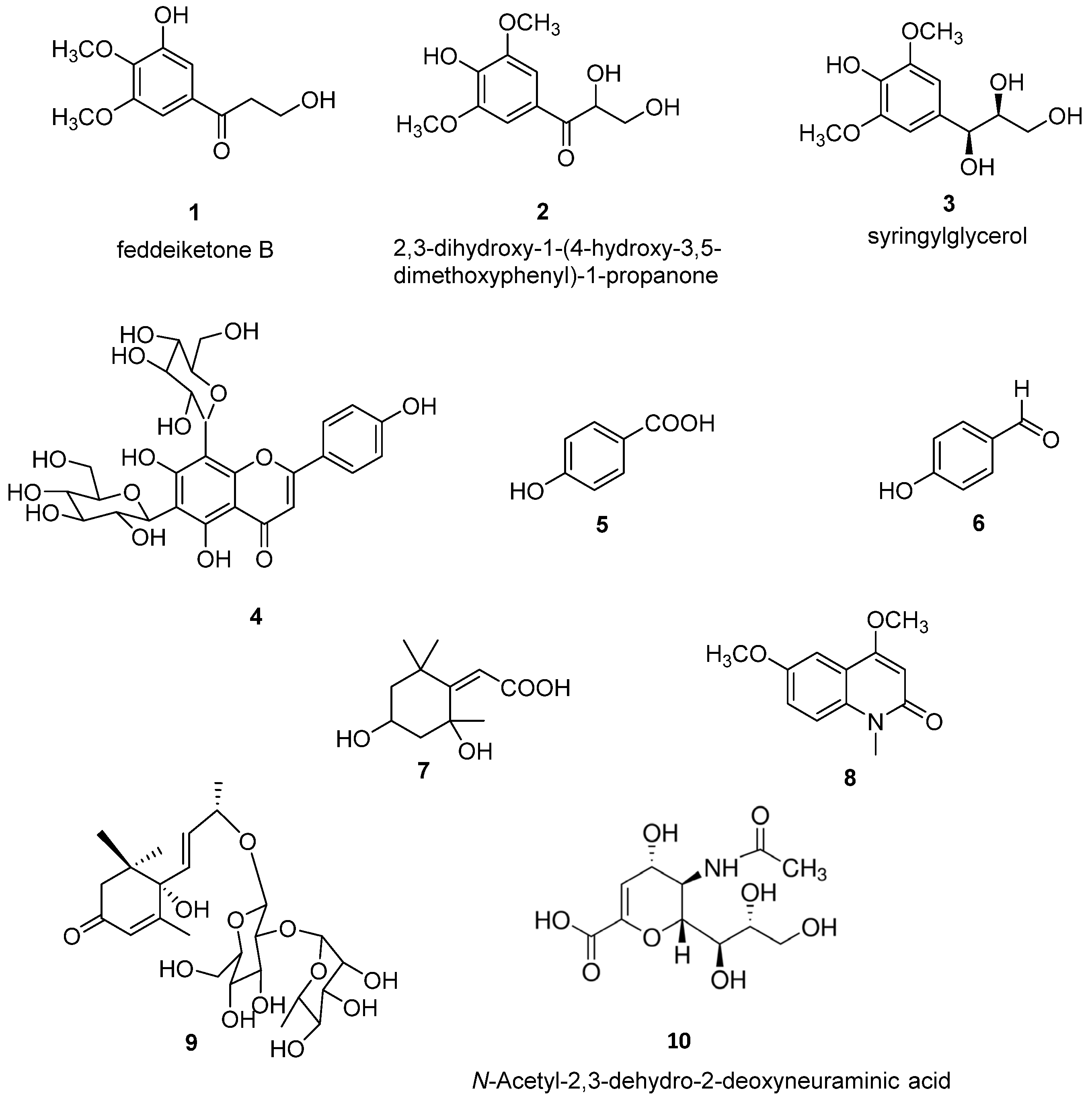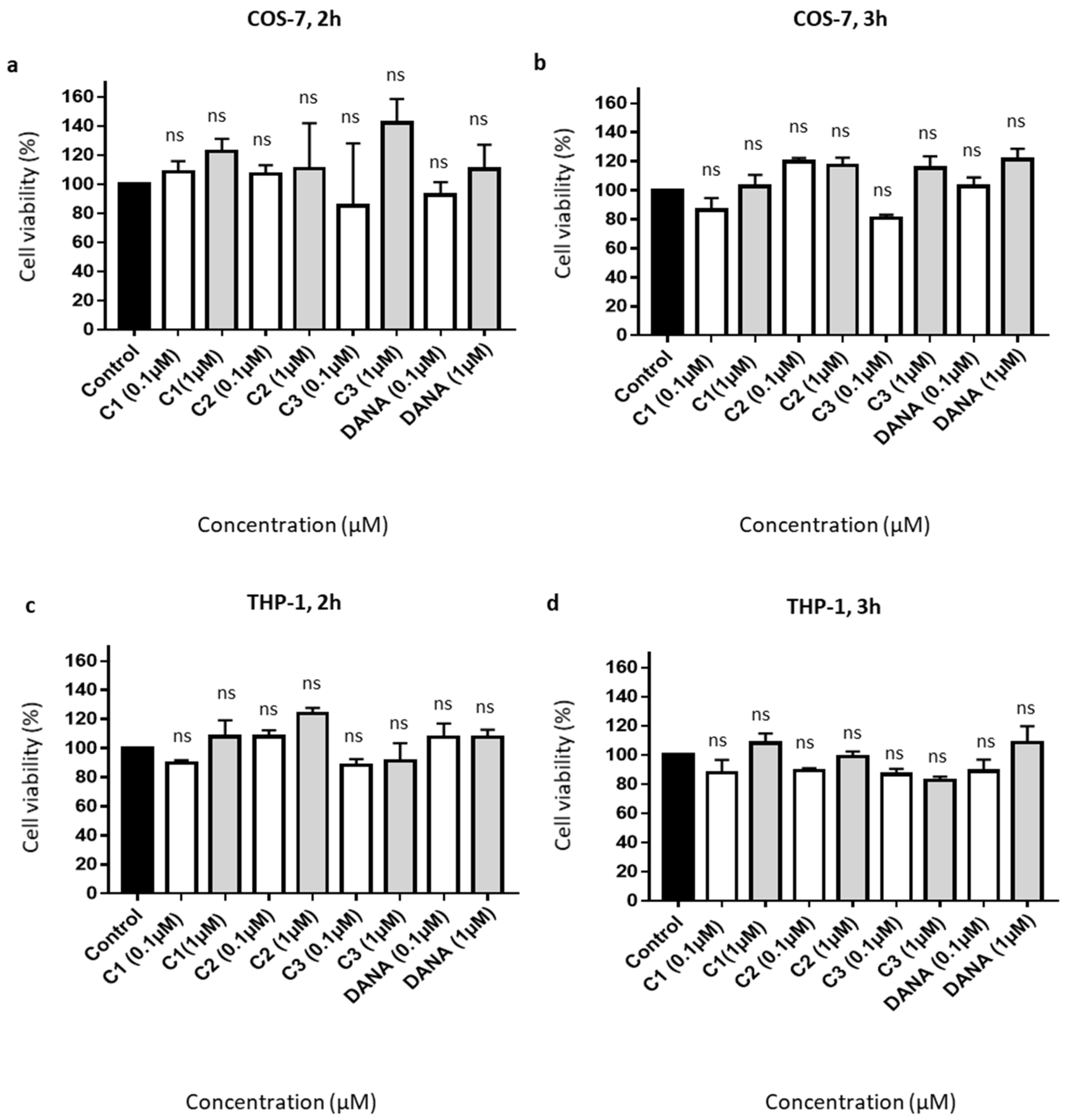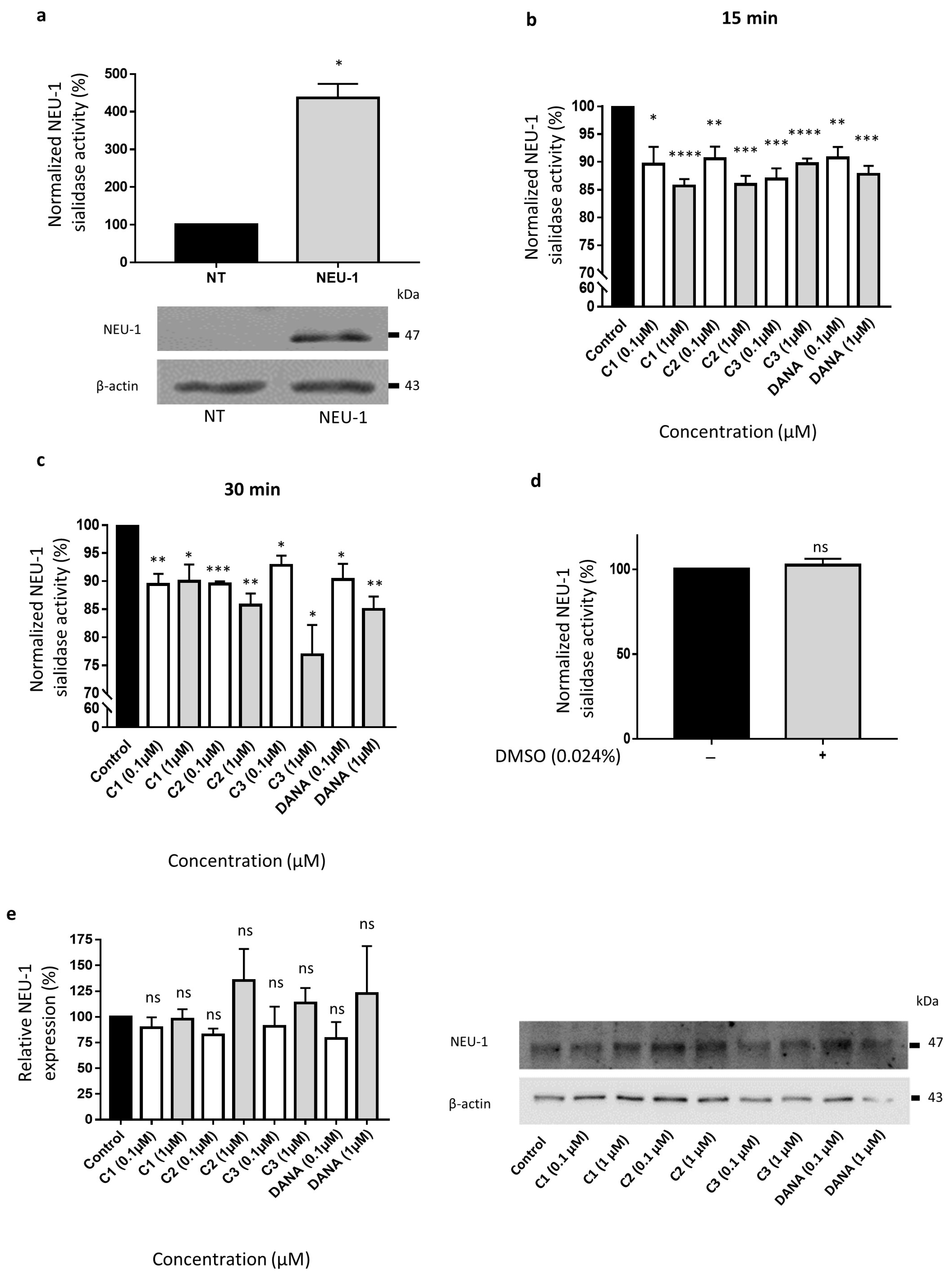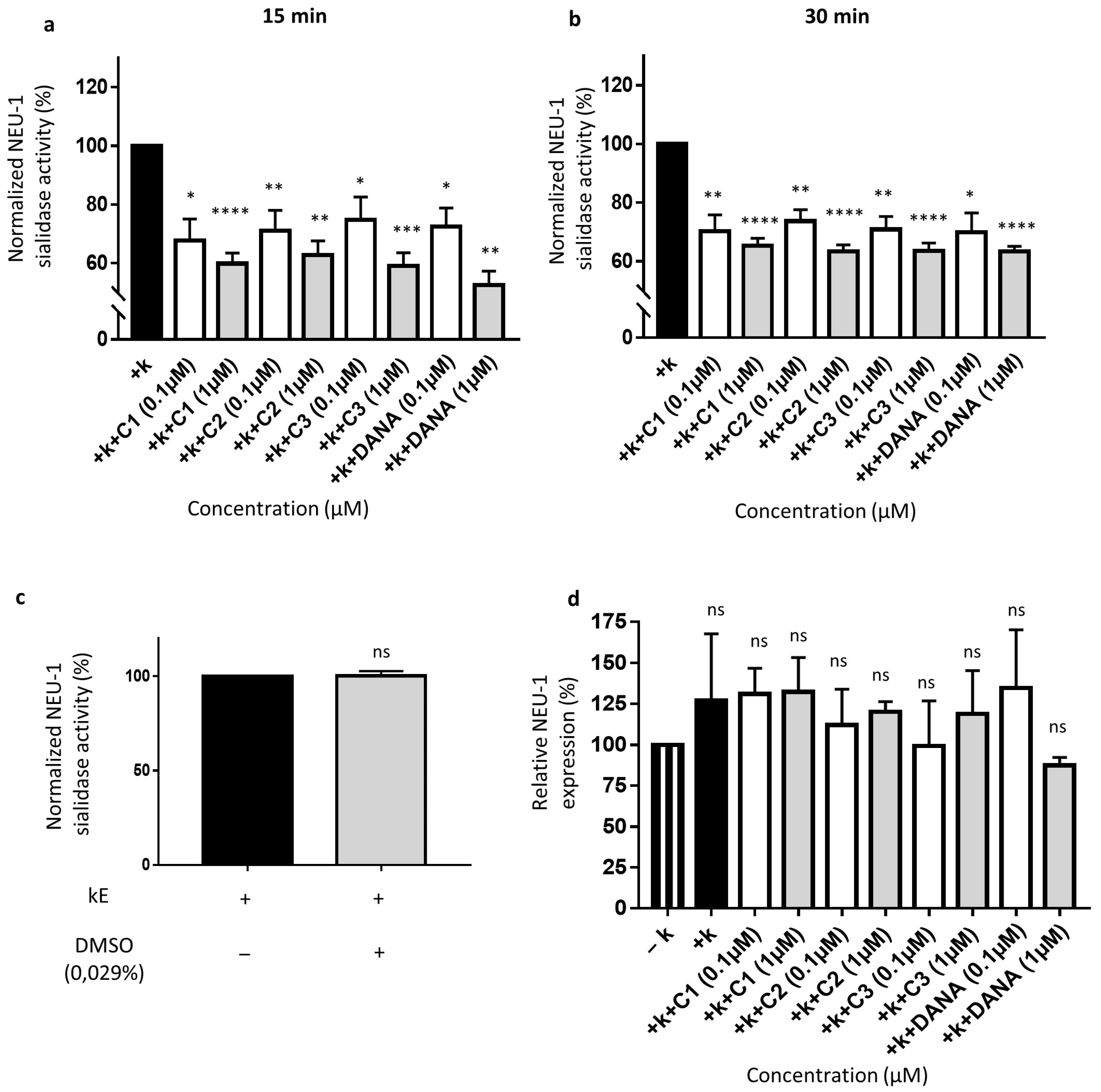Identification and Evaluation of New Potential Inhibitors of Human Neuraminidase 1 Extracted from Olyra latifolia L.: A Preliminary Study
Abstract
1. Introduction
2. Materials and Methods
2.1. General Procedures
2.2. Plant Material
2.3. Extraction and Isolation
2.4. Compound Solubilization
2.5. MTT Assay
2.6. Plasmids and Transfection Reagent
2.7. Cell Culture and Transfection
2.8. Sialidase Activity
2.9. Western Blot
2.10. Statistical Analysis
3. Results
3.1. Structure Identification
3.1.1. Compound 1
3.1.2. Compound 2
3.1.3. Compound 3
3.1.4. Compound 4
3.1.5. Compound 5
3.1.6. Compound 6
3.1.7. Compound 7
3.1.8. Compound 8
3.1.9. Compound 9
3.2. Effects of Selected Compounds 1–3 on Cell Viability
3.3. Effects of Selected Compounds 1–3 on Sialidase Activity in COS-7 Cells Overexpressing NEU-1
3.4. Effects of Compounds 1–3 on Membrane NEU-1 Mediated Sialidase Activity Triggered by Elastin-Derived Peptides in THP-1 Cells
4. Discussion
Author Contributions
Funding
Institutional Review Board Statement
Informed Consent Statement
Data Availability Statement
Conflicts of Interest
References
- Giacopuzzi, E.; Bresciani, R.; Schauer, R.; Monti, E.; Borsani, G. New Insights on the Sialidase Protein Family Revealed by a Phylogenetic Analysis in Metazoa. PLoS ONE 2012, 7, e44193. [Google Scholar] [CrossRef]
- Bennasroune, A.; Romier-Crouzet, B.; Blaise, S.; Laffargue, M.; Efremov, R.G.; Martiny, L.; Maurice, P.; Duca, L. Elastic Fibers and Elastin Receptor Complex: Neuraminidase-1 Takes the Center Stage. Matrix Biol. 2019, 84, 57–67. [Google Scholar] [CrossRef] [PubMed]
- Blaise, S.; Romier, B.; Kawecki, C.; Ghirardi, M.; Rabenoelina, F.; Baud, S.; Duca, L.; Maurice, P.; Heinz, A.; Schmelzer, C.E.H.; et al. Elastin-Derived Peptides Are New Regulators of Insulin Resistance Development in Mice. Diabetes 2013, 62, 3807–3816. [Google Scholar] [CrossRef] [PubMed]
- Gayral, S.; Garnotel, R.; Castaing-Berthou, A.; Blaise, S.; Fougerat, A.; Berge, E.; Montheil, A.; Malet, N.; Wymann, M.P.; Maurice, P.; et al. Elastin-Derived Peptides Potentiate Atherosclerosis through the Immune Neu1-PI3Kγ Pathway. Cardiovasc. Res. 2014, 102, 118–127. [Google Scholar] [CrossRef] [PubMed]
- Li, J.; van der Wal, D.E.; Zhu, G.; Xu, M.; Yougbare, I.; Ma, L.; Vadasz, B.; Carrim, N.; Grozovsky, R.; Ruan, M.; et al. Desialylation Is a Mechanism of Fc-Independent Platelet Clearance and a Therapeutic Target in Immune Thrombocytopenia. Nat. Commun. 2015, 6, 7737. [Google Scholar] [CrossRef] [PubMed]
- Romier, B.; Ivaldi, C.; Sartelet, H.; Heinz, A.; Schmelzer, C.E.H.; Garnotel, R.; Guillot, A.; Jonquet, J.; Bertin, E.; Guéant, J.-L.; et al. Production of Elastin-Derived Peptides Contributes to the Development of Nonalcoholic Steatohepatitis. Diabetes 2018, 67, 1604–1615. [Google Scholar] [CrossRef]
- Hornebeck, W.; Robinet, A.; Duca, L.; Antonicelli, F.; Wallach, J.; Bellon, G. The Elastin Connection and Melanoma Progression. Anticancer Res. 2005, 9, 2617–2625. [Google Scholar]
- Ntayi, C.; Labrousse, A.-L.; Debret, R.; Birembaut, P.; Bellon, G.; Antonicelli, F.; Hornebeck, W.; Bernard, P. Elastin-Derived Peptides Upregulate Matrix Metalloproteinase-2-Mediated Melanoma Cell Invasion through Elastin-Binding Protein. J. Investig. Dermatol. 2004, 122, 256–265. [Google Scholar] [CrossRef]
- Pocza, P.; Süli-Vargha, H.; Darvas, Z.; Falus, A. Locally Generated VGVAPG and VAPG Elastin-Derived Peptides Amplify Melanoma Invasion via the Galectin-3 Receptor. Int. J. Cancer 2008, 122, 1972–1980. [Google Scholar] [CrossRef]
- Haxho, F.; Allison, S.; Alghamdi, F.; Brodhagen, L.; Kuta, V.E.; Abdulkhalek, S.; Neufeld, R.J.; Szewczuk, M.R. Oseltamivir Phosphate Monotherapy Ablates Tumor Neovascularization, Growth, and Metastasis in Mouse Model of Human Triple-Negative Breast Adenocarcinoma. Breast Cancer 2014, 6, 191–203. [Google Scholar] [CrossRef][Green Version]
- Nicoloff, G.; Deliiyski, T.; Nikolov, A. Detection of Serum Collagen Collagen Type IV and Elastin Derived Peptides in Patients with Breast Cancer. Diabetol. Croat. 2010, 11, 83–93. [Google Scholar]
- Salesse, S.; Odoul, L.; Chazée, L.; Garbar, C.; Duca, L.; Martiny, L.; Mahmoudi, R.; Debelle, L. Elastin Molecular Aging Promotes MDA-MB-231 Breast Cancer Cell Invasiveness. FEBS Open Biol. 2018, 8, 1395–1404. [Google Scholar] [CrossRef]
- Thulasiraman, P.; Kerr, K.; McAlister, K.; Hardisty, S.; Wistner, A.; McCullough, I. Neuraminidase 1 Regulates Proliferation, Apoptosis and the Expression of Cadherins in Mammary Carcinoma Cells. Mol. Cell. Biochem. 2019, 462, 207–215. [Google Scholar] [CrossRef]
- Ren, L.; Zhang, L.; Huang, S.; Zhu, Y.; Li, W.; Fang, S.; Shen, L.; Gao, Y. Effects of Sialidase NEU1 SiRNA on Proliferation, Apoptosis, and Invasion in Human Ovarian Cancer. Mol. Cell. Biochem. 2016, 411, 213–219. [Google Scholar] [CrossRef]
- Chavas, L.M.G.; Tringali, C.; Fusi, P.; Venerando, B.; Tettamanti, G.; Kato, R.; Monti, E.; Wakatsuki, S. Crystal Structure of the Human Cytosolic Sialidase Neu2. Evidence for the Dynamic Nature of Substrate Recognition. J. Biol. Chem. 2005, 280, 469–475. [Google Scholar] [CrossRef] [PubMed]
- Magesh, S.; Suzuki, T.; Miyagi, T.; Ishida, H.; Kiso, M. Homology Modeling of Human Sialidase Enzymes NEU1, NEU3 and NEU4 Based on the Crystal Structure of NEU2: Hints for the Design of Selective NEU3 Inhibitors. J. Mol. Graph. Model. 2006, 25, 196–207. [Google Scholar] [CrossRef]
- O’Shea, L.K.; Abdulkhalek, S.; Allison, S.; Neufeld, R.J.; Szewczuk, M.R. Therapeutic Targeting of Neu1 Sialidase with Oseltamivir Phosphate (Tamiflu®) Disables Cancer Cell Survival in Human Pancreatic Cancer with Acquired Chemoresistance. Onco. Targets Ther. 2014, 7, 117–134. [Google Scholar] [CrossRef] [PubMed][Green Version]
- Scandolera, A.; Odoul, L.; Salesse, S.; Guillot, A.; Blaise, S.; Kawecki, C.; Maurice, P.; El Btaouri, H.; Romier-Crouzet, B.; Martiny, L.; et al. The Elastin Receptor Complex: A Unique Matricellular Receptor with High Anti-Tumoral Potential. Front. Pharmacol. 2016, 7, 32. [Google Scholar] [CrossRef] [PubMed]
- Duca, L.; Blanchevoye, C.; Cantarelli, B.; Ghoneim, C.; Dedieu, S.; Delacoux, F.; Hornebeck, W.; Hinek, A.; Martiny, L.; Debelle, L. The Elastin Receptor Complex Transduces Signals through the Catalytic Activity of Its Neu-1 Subunit. J. Biol. Chem. 2007, 282, 12484–12491. [Google Scholar] [CrossRef] [PubMed]
- Hinek, A.; Bodnaruk, T.D.; Bunda, S.; Wang, Y.; Liu, K. Neuraminidase-1, a Subunit of the Cell Surface Elastin Receptor, Desialylates and Functionally Inactivates Adjacent Receptors Interacting with the Mitogenic Growth Factors PDGF-BB and IGF-2. Am. J. Pathol. 2008, 173, 1042–1056. [Google Scholar] [CrossRef] [PubMed]
- Privitera, S.; Prody, C.A.; Callahan, J.W.; Hinek, A. The 67-KDa Enzymatically Inactive Alternatively Spliced Variant of Beta-Galactosidase Is Identical to the Elastin/Laminin-Binding Protein. J. Biol. Chem. 1998, 273, 6319–6326. [Google Scholar] [CrossRef] [PubMed]
- Guo, T.; Héon-Roberts, R.; Zou, C.; Zheng, R.; Pshezhetsky, A.V.; Cairo, C.W. Selective Inhibitors of Human Neuraminidase 1 (NEU1). J. Med. Chem. 2018, 61, 11261–11279. [Google Scholar] [CrossRef] [PubMed]
- Magesh, S.; Moriya, S.; Suzuki, T.; Miyagi, T.; Ishida, H.; Kiso, M. Design, Synthesis, and Biological Evaluation of Human Sialidase Inhibitors. Part 1: Selective Inhibitors of Lysosomal Sialidase (NEU1). Bioorg. Med. Chem. Lett. 2008, 18, 532–537. [Google Scholar] [CrossRef] [PubMed]
- Albrecht, C.; Kuznetsov, A.S.; Appert-Collin, A. Transmembrane Peptides as a New Strategy to Inhibit Neuraminidase-1 Activation. Front. Cell Dev. Biol. 2020, 8, 611121. [Google Scholar] [CrossRef] [PubMed]
- Albrecht, C.; Appert-Collin, A.; Bagnard, D.; Blaise, S.; Romier-Crouzet, B.; Efremov, R.G.; Sartelet, H.; Duca, L.; Maurice, P.; Bennasroune, A. Transmembrane Peptides as Inhibitors of Protein-Protein Interactions: An Efficient Strategy to Target Cancer Cells? Front. Oncol. 2020, 10, 519. [Google Scholar] [CrossRef]
- Burkill, H.M. The Useful Plants of West Tropical Africa. Vol. 2: Families E-I, 2nd ed.; Royal Botanic Gardens: Kew, UK, 1994; ISBN 978-0-947643-56-0. [Google Scholar]
- Vergiat, A.-M. Plantes magiques et médicinales des Féticheurs de l’Oubangui (Région de Bangui) (suite). JATBA 1970, 17, 60–91. [Google Scholar] [CrossRef]
- Bamba, B. Bulletin Official de La Propriété Industrielle (BIOPI). Brevets d’inventions N°06BR/2014 Du, 21 October 2015. [Google Scholar]
- Coe, F.G.; Parikh, D.M.; Johnson, C.A.; Anderson, G.J. The Good and the Bad: Alkaloid Screening and Brineshrimp Bioassays of Aqueous Extracts of 31 Medicinal Plants of Eastern Nicaragua. Pharm. Biol. 2012, 50, 384–392. [Google Scholar] [CrossRef]
- DeFilipps, R.A.; Marina, S.L.; Crepin, J. Medicinal Plants of the Guianas (Guyana, Surinam, French Guiana); Department of Botany, National Museum of Natural History, Smithsonian Institution: Washington, DC, USA, 2004. [Google Scholar]
- Gibbs, R.D. Chemotaxonomy of Flowering Plants; McGill-Queen’s University Press: Montreal, QC, Canada, 1974; ISBN 978-0-7735-0098-3. [Google Scholar]
- Bonten, E.J.; Campos, Y.; Zaitsev, V.; Nourse, A.; Waddell, B.; Lewis, W.; Taylor, G.; d’Azzo, A. Heterodimerization of the Sialidase NEU1 with the Chaperone Protective Protein/Cathepsin A Prevents Its Premature Oligomerization. J. Biol. Chem. 2009, 284, 28430–28441. [Google Scholar] [CrossRef]
- Kawecki, C.; Bocquet, O.; Schmelzer, C.E.H.; Heinz, A.; Ihling, C.; Wahart, A.; Romier, B.; Bennasroune, A.; Blaise, S.; Terryn, C.; et al. Identification of CD36 as a New Interaction Partner of Membrane NEU1: Potential Implication in the pro-Atherogenic Effects of the Elastin Receptor Complex. Cell. Mol. Life Sci. 2019, 76, 791–807. [Google Scholar] [CrossRef]
- Lu, Y.; Li, X.; Mu, H.; Huang, H.; Li, G.-P.; Hu, Q. Bioactive Phenylpropanoids from Daphne Feddei. J. Braz. Chem. Soc. 2012, 23, 5. [Google Scholar] [CrossRef][Green Version]
- Lee, T.-H.; Kuo, Y.-C.; Wang, G.-J.; Kuo, Y.-H.; Chang, C.-I.; Lu, C.-K.; Lee, C.-K. Five New Phenolics from the Roots of Ficus b. Eecheyana. J. Nat. Prod. 2002, 65, 1497–1500. [Google Scholar] [CrossRef]
- Otsuka, H.; Takeuchi, M.; Inoshiri, S.; Sato, T.; Yamasaki, K. Phenolic Compounds from Coix Lachryma-Jobi Var. Ma-Yuen. Phytochemistry 1989, 28, 883–886. [Google Scholar] [CrossRef]
- Velozo, L.S.M.; Ferreira, M.J.P.; Santos, M.I.S.; Moreira, D.L.; Guimarães, E.F.; Emerenciano, V.P.; Kaplan, M.A.C. C-Glycosyl Flavones from Peperomia Blanda. Fitoterapia 2009, 80, 119–122. [Google Scholar] [CrossRef] [PubMed]
- Xin, X.L.; Aisa, H.A.; Wang, H.Q. Flavonoids and Phenolic Compounds from Seeds of the Chinese Plant Nigella Glandulifera. Chem. Nat. Compd. 2008, 44, 368–369. [Google Scholar] [CrossRef]
- Shimada, A.; Takeuchi, S.; Nakajima, A.; Tanaka, S.; Kawano, T.; Kimura, Y. Phytotoxicity of Indole-3-Acetic Acid Produced by the Fungus. Pythium Aphanidermatum Biosci. Biotechnol. Biochem. 2000, 64, 187–189. [Google Scholar] [CrossRef] [PubMed][Green Version]
- Wu, Y.; Su, J.; Guo, R.; Ren, T.; Zhang, M.; Dong, M.; Sauriol, F.; Shi, Q.; Gu, Y.; Huo, C. Two New Non-Taxoids from Leaves of Taxus Cuspidata. Chem. Nat. Compd. 2014, 50, 603–605. [Google Scholar] [CrossRef]
- Campbell, W.E.; Davidowitz, B.; Jackson, G.E. Quinolinone Alkaloids from an Agathosma Species. Phytochemistry 1990, 29, 1303–1306. [Google Scholar] [CrossRef]
- Okamura, N.; Yagi, A.; Nishioka, I. Studies on the Constituents of Zizyphi Fructus. V. Structures of Glycosides of Benzyl Alcohol, Vomifoliol and Naringenin. Chem. Pharm. Bull. 1981, 29, 3507–3514. [Google Scholar] [CrossRef]
- Bonten, E.J.; Annunziata, I.; d’Azzo, A. Lysosomal Multienzyme Complex: Pros and Cons of Working Together. Cell. Mol. Life Sci. 2014, 71, 2017–2032. [Google Scholar] [CrossRef] [PubMed]
- Hou, G.; Liu, G.; Yang, Y.; Li, Y.; Yuan, S.; Zhao, L.; Wu, M.; Liu, L.; Zhou, W. Neuraminidase 1 (NEU1) Promotes Proliferation and Migration as a Diagnostic and Prognostic Biomarker of Hepatocellular Carcinoma. Oncotarget 2016, 7, 64957–64966. [Google Scholar] [CrossRef]
- Hyun, S.W.; Liu, A.; Liu, Z.; Cross, A.S.; Verceles, A.C.; Magesh, S.; Kommagalla, Y.; Kona, C.; Ando, H.; Luzina, I.G.; et al. The NEU1-Selective Sialidase Inhibitor, C9-Butyl-Amide-DANA, Blocks Sialidase Activity and NEU1-Mediated Bioactivities in Human Lung in Vitro and Murine Lung in Vivo. Glycobiology 2016, 26, 834–849. [Google Scholar] [CrossRef] [PubMed]




Publisher’s Note: MDPI stays neutral with regard to jurisdictional claims in published maps and institutional affiliations. |
© 2021 by the authors. Licensee MDPI, Basel, Switzerland. This article is an open access article distributed under the terms and conditions of the Creative Commons Attribution (CC BY) license (https://creativecommons.org/licenses/by/4.0/).
Share and Cite
Albrecht, C.; Akissi, Z.L.E.; Yao-Kouassi, P.A.; Alabdul Magid, A.; Maurice, P.; Duca, L.; Voutquenne-Nazabadioko, L.; Bennasroune, A. Identification and Evaluation of New Potential Inhibitors of Human Neuraminidase 1 Extracted from Olyra latifolia L.: A Preliminary Study. Biomedicines 2021, 9, 411. https://doi.org/10.3390/biomedicines9040411
Albrecht C, Akissi ZLE, Yao-Kouassi PA, Alabdul Magid A, Maurice P, Duca L, Voutquenne-Nazabadioko L, Bennasroune A. Identification and Evaluation of New Potential Inhibitors of Human Neuraminidase 1 Extracted from Olyra latifolia L.: A Preliminary Study. Biomedicines. 2021; 9(4):411. https://doi.org/10.3390/biomedicines9040411
Chicago/Turabian StyleAlbrecht, Camille, Zachée Louis Evariste Akissi, Philomène Akoua Yao-Kouassi, Abdulmagid Alabdul Magid, Pascal Maurice, Laurent Duca, Laurence Voutquenne-Nazabadioko, and Amar Bennasroune. 2021. "Identification and Evaluation of New Potential Inhibitors of Human Neuraminidase 1 Extracted from Olyra latifolia L.: A Preliminary Study" Biomedicines 9, no. 4: 411. https://doi.org/10.3390/biomedicines9040411
APA StyleAlbrecht, C., Akissi, Z. L. E., Yao-Kouassi, P. A., Alabdul Magid, A., Maurice, P., Duca, L., Voutquenne-Nazabadioko, L., & Bennasroune, A. (2021). Identification and Evaluation of New Potential Inhibitors of Human Neuraminidase 1 Extracted from Olyra latifolia L.: A Preliminary Study. Biomedicines, 9(4), 411. https://doi.org/10.3390/biomedicines9040411






